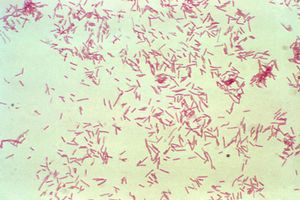Bacteroides fragilis
Introduction
Bacteroides fragilis (BF) is a Gram-negative bacterium found in the human colon [1]. It is responsible for a large number of opportunistic infections in hospitals and contributes significantly to morbidity and mortality [2]. In addition to opportunistic infections, BF has been known to cause complications such as colorectal cancer and cholitis. [3] This bacterium is of interest to researchers because of its ability to evade immune responses and evolving drug resistance.

At right is a sample image insertion. It works for any image uploaded anywhere to MicrobeWiki. The insertion code consists of:
Double brackets: [[
Filename: PHIL_1181_lores.jpg
Thumbnail status: |thumb|
Pixel size: |300px|
Placement on page: |right|
Legend/credit: Electron micrograph of the Ebola Zaire virus. This was the first photo ever taken of the virus, on 10/13/1976. By Dr. F.A. Murphy, now at U.C. Davis, then at the CDC.
Closed double brackets: ]]
Other examples:
Bold
Italic
Subscript: H2O
Superscript: Fe3+
Section 1 Genetics
Include some current research, with at least one image.
Sample citations: [1]
[2]
A citation code consists of a hyperlinked reference within "ref" begin and end codes.
Section 2 Microbiome
Include some current research, with a second image.
Conclusion
Overall text length should be at least 1,000 words (before counting references), with at least 2 images. Include at least 5 references under Reference section.
References
[1] Kuwahara, Tomomi, et al. "Genomic analysis of Bacteroides fragilis reveals extensive DNA inversions regulating cell surface adaptation." Proceedings of the National Academy of Sciences 101.41 (2004): 14919-14924.
[2] Carolyn Redondo, Maria, et al. "Attributable mortality of bacteremia associated with the Bacteroides fragilis group." Clinical infectious diseases 20.6 (1995): 1492-1496.
[3] Sears, Cynthia L. "Enterotoxigenic Bacteroides fragilis: a rogue among symbiotes." Clinical microbiology reviews 22.2 (2009): 349-369.
Edited by James Cawthon, student of Joan Slonczewski for BIOL 116 Information in Living Systems, 2019, Kenyon College.
